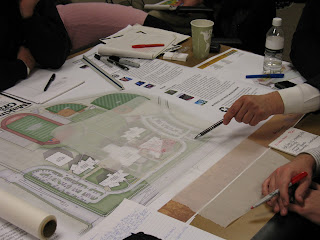Charrettes have gained in popularity in recent years as a tool to increase collaboration and communication among building stakeholders, and to efficiently focus the time and attention of design team members in order to achieve greater synergy and sustainability. However, little research exists documenting outcomes of the charrette process and its role in the overall success of sustainable building projects. To learn more about this relationship, we conducted a research study surveying LEED-NC 2009 project contacts and asked what characteristics were present during the charrette process.
The study’s results showed that implementing charrettes in LEED projects increased the amount of points a project received by 7 on average compared to projects that did not use charrettes.
In addition to this finding, three separate characteristics were found to negatively impact the the number of LEED points a building received. We consider these three characteristics constraining factors, since they limit what happens during a charrette. The characteristics which were found to negatively impact LEED achievement included:
- using a charrette as a LEED strategy or checklist meeting,
- having a defined structured agenda, and
- having pre-defined project goals before the charrettes take place.
Results of the study suggest the charrette process has the potential to provide significant benefits, regardless of what characteristics are implemented. But to fully realize these benefits, a charrette should not include factors that limit a group’s ability to produce creative ideas, goals and innovative solutions. Thus, charrettes are best conducted to encourage open-ended dialogue, brainstorming and creative solutions to problems as vetted thoroughly and rapidly among many people with interdisciplinary backgrounds.
This research project was conducted as part of the Masters thesis of Michael Knox, graduate student in the department of Construction Management at Colorado State University. Michael’s thesis committee included, Caroline Clevenger, Ph.D., Brian Dunbar, and Katharine Leigh, Ph.D. To learn more about this research project, please download the full research document here. You can also contact the author on LinkedIn.

